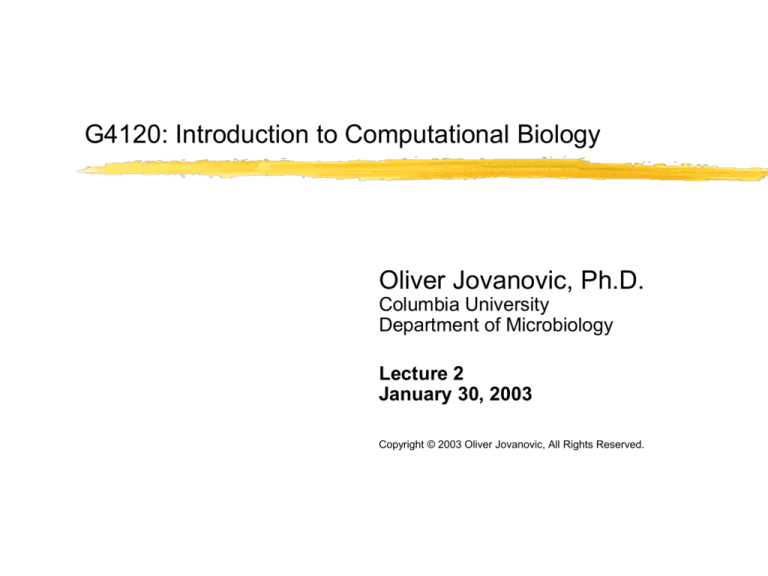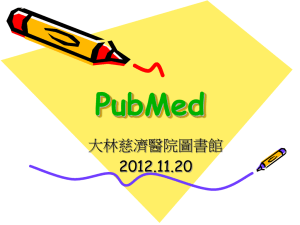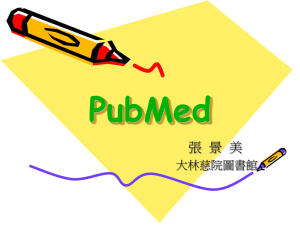
G4120: Introduction to Computational Biology
Oliver Jovanovic, Ph.D.
Columbia University
Department of Microbiology
Lecture 2
January 30, 2003
Copyright © 2003 Oliver Jovanovic, All Rights Reserved.
Binary Computing
Modern computers are digital, and function at the binary level, with the most
basic measure of information, a bit, representing only one of two possibilities: 0
or 1.
1 bit =
2 bits =
3 bits =
4 bits =
5 bits =
6 bits =
7 bits =
8 bits =
0
or
1
0
or
1
0
or
1
0
or
1
0
or
1
0
or
1
0
or
1
0
or
1
= 2 possibilities
0
or
1
0
or
1
0
or
1
0
or
1
0
or
1
0
or
1
0
or
1
= 2 x 2 = 4 possibilities
0
or
1
0
or
1
0
or
1
0
or
1
0
or
1
0
or
1
= 2 x 2 x 2 = 8 possibilities
0
or
1
0
or
1
0
or
1
0
or
1
0
or
1
= 2 x 2 x 2 x 2 = 16 possibilities
0
or
1
0 0
or or
1 1
0 0 0
or or or
1 1 1
0 0 0 0
or or or or
1 1 1 1
= 2 x 2 x 2 x 2 x 2 = 32 possibilities
= 2 x 2 x 2 x 2 x 2 x 2 = 64 possibilities
= 2 x 2 x 2 x 2 x 2 x 2 x 2 = 128 possibilities
= 2 x 2 x 2 x 2 x 2 x 2 x 2 x 2 = 256 possibilities
Binary Representation of DNA
DNA has only four possibilities (so can be represented by 2 bits)
G = 00
C = 11
A = 01
T = 10
Complementation (with intelligent choice of representation)
G C C A = 00 11 11 01
C G G T = 11 00 00 10
Additional Binary Units
8 bits = 1 byte
1,024 bits = 1 kilobit
1,024 bytes (approximately 1 thousand bytes) = 1 kilobyte (K)
1,024 kilobytes (approximately 1 million bytes) = 1 megabyte (M)
1,024 megabytes (approximately 1 billion bytes) = 1 gigabyte (G)
1,024 gigabytes (approximately 1 trillion bytes) = 1 terabyte (T)
ASCII Representation of DNA
American Standard Code for Information Interchange (ASCII)
• For practical purposes, DNA and RNA is generally represented in ASCII code, using the upper or lower
case
letters A, C, G, and T or A, C, G and U.
• Each ASCII character occupies one byte, and thus has 256 possibilities, including all upper and lower
case letters of the English alphabet, the ten Arabic numerals, punctuation, and special characters, such
as @.
• Thus, a kilobase of DNA (1,000 base pairs) occupies just under a kilobyte of storage in ASCII. An entire
human
genome, roughly 3 billion base pairs, occupies just under 3 gigabytes of storage in ASCII.
Transcription
Transcription is computationally trivial. One need only substitute a U for a T if dealing with a sense strand,
or complement, then transcribe if dealing with the antisense strand.
Translation
Translation is also computationally trivial task. A computer program can refer to a species appropriate
translation table to translate DNA or RNA into the appropriate protein sequence.
AUA
AUC
AUG
AUU
etc.
I
I
M
I
Isoleucine
Isoleucine
Methionine start
Isoleucine
Alternate Representation
Can readily convert an ASCII representation of DNA into other forms, such as graphics, or even music.
Algorithms in Computational Biology
Algorithm
An algorithm is simply a series of steps used to solve a problem. One of a computer's great strengths is its ability
to rapidly and accurately repeat recursive steps in an algorithm.
Computational Biology Algorithms
Early algorithms for searching sequence data depended on consensus sequences. Thus, to find a prokaryotic
promoter, one would try to find something that matched a consensus -10 sequence (TATAAT), not too far
downstream of a consensus -35 sequence (TTGACA).
It rapidly became clear that biologically significant sequences rarely perfectly matched a consensus, and more
sophisticated approaches were adopted, including the use of matrices, Markov chains and hidden Markov
models.
Matrices take into account the distribution of every possible nucleotide (or amino acid) at a position in a set of
known sequences. Searching with a matrix is therefore more sensitive than searching with a consensus, and can
find biological features that a strict consensus approach would miss.
Markov chains and hidden Markov models are probabilistic models of sequences, and have proven useful in
database searching, gene finding and multiple sequence alignment.
Consensus v. Matrix
Consensus
-35
-10
TTGACA.................TATAAT
Matrix
A
C
G
T
-35 Region
T T G A C A
11 8 8 7 8 7 3 5 5 0 1 0 14 5 9 5
3 4 2 4 4 3 5 2 8 1 1 2 3 11 2 5
3 2 4 2 4 5 5 5 5 2 1 17 1 2 3 3
4 7 7 8 5 6 8 9 3 17 18 2 4 3 7 9
Spacer Region
Length 9 10 11 12 13 14 15
1 6 14 6 1 1 1
A
C
G
T
4 5
5 4
2 5
10 6
3
5
5
8
T
4
4
8
5
-10 Region
A T A A T
4 0 20 5 12 11 0 7 4 6
5 2 0 3 3 4 1 2 7 6
7 2 0 3 3 3 0 6 5 6
6 17 1 9 3 4 20 6 5 4
Search Algorithms in Computational Biology
Global Alignment Search
Needleman-Wunsch algorithm, Needleman & Wunsch, 1970
• Finds the best alignment of two complete sequences that maximizes the number of matches and
minimizes the number of gaps.
Local Alignment Search
Smith-Waterman algorithm, Smith & Waterman, 1981
• Makes an optimal alignment of the best segment of similarity between two sequences.
• Often better for comparing sequences of different lengths, or when looking at a particular region of interest.
Heuristic Approximations to Smith-Waterman
FASTA, Pearson, 1988
BLAST, Altschul, 1990
BLAST 2 (aka Gapped BLAST), Altschul, 1997
Global Alignment (Needleman-Wunsch)
Gap uses the algorithm of Needleman and Wunsch to find the alignment of two complete sequences that
maximizes the number of matches and minimizes the number of gaps.
GAP RK2_ssb x Ecoli_ssb
January 29, 2003 00:07
.
.
.
.
.
1 ..MSHNQFQFIGNLTRDTEVRHGNSNKPQAIFDIAVNEEWRNDA.GDKQE 47
|. :||| .| |||: . | :| .| ||. | |: .|
1 ASRGVNKVILVGNLGQDPEVRYMPNGGAVANITLATSESWRDKATGEMKE 50
.
.
.
.
.
48 RTDFFRIKCFGSQAEAHGKYLGKGSLVFVQGKIRNTKY.EKDGQTVYGTD 96
.|:. |: || || .|| ||| |:::|.:| |: :. || | |:
51 QTEWHRVVLFGKLAEVASEYLRKGSQVYIEGQLRTRKWTDQSGQDRYTTE 100
.
.
.
.
.
97 FIAD...KVDYLDTKAPGGSNQE........................... 116
: . . | : ||.
101 VVVNVGGTMQMLGGRQGGGAPAGGNIGGGQPQGGWGQPQQPQGGNQFSGG 150
.
.
...........................
151 AQSRPQQSAPAAPSNEPPMDFDDDIPF 177
Matrix: blosum62
Gap Penalties: default
Length: 177
Percent Similarity: 45.690
Percent Identity: 32.759
Local Alignment (Smith-Waterman)
BestFit makes an optimal alignment of the best segment of similarity between two sequences. Optimal
alignments are found by inserting gaps to maximize the number of matches using the local homology
algorithm of Smith and Waterman.
BESTFIT RK2_ssb x Ecoli_ssb
January 29, 2003 00:08
.
.
.
.
.
4 NQFQFIGNLTRDTEVRHGNSNKPQAIFDIAVNEEWRNDA.GDKQERTDFF 52
|. :||| .| |||: . | :| .| ||. | |: .|.|:.
6 NKVILVGNLGQDPEVRYMPNGGAVANITLATSESWRDKATGEMKEQTEWH 55
.
.
.
.
53 RIKCFGSQAEAHGKYLGKGSLVFVQGKIRNTKY.EKDGQTVYGTDFIAD 100
|: || || .|| ||| |:::|.:| |: :. || | |: : .
56 RVVLFGKLAEVASEYLRKGSQVYIEGQLRTRKWTDQSGQDRYTTEVVVN 104
Matrix: blosum62
Gap Penalties: default
Length: 99
Percent Similarity: 50.515
Percent Identity: 36.082
Global v. Local Alignment
1 ..MSHNQFQFIGNLTRDTEVRHGNSNKPQAIFDIAVNEEWRNDA.GDKQE 47
|. :||| .| |||: . | :| .| ||. | |: .|
1 ASRGVNKVILVGNLGQDPEVRYMPNGGAVANITLATSESWRDKATGEMKE 50
.
.
.
.
.
48 RTDFFRIKCFGSQAEAHGKYLGKGSLVFVQGKIRNTKY.EKDGQTVYGTD 96
.|:. |: || || .|| ||| |:::|.:| |: :. || | |:
51 QTEWHRVVLFGKLAEVASEYLRKGSQVYIEGQLRTRKWTDQSGQDRYTTE 100
.
.
.
.
.
97 FIAD...KVDYLDTKAPGGSNQE........................... 116
: . . | : ||.
101 VVVNVGGTMQMLGGRQGGGAPAGGNIGGGQPQGGWGQPQQPQGGNQFSGG 150
.
.
...........................
151 AQSRPQQSAPAAPSNEPPMDFDDDIPF 177
Search Algorithm Details
Dayhoff Matrices
For protein comparison, all of these search algorithms use Dayhoff substitution matrices which encode log
likelihoods of an amino acid substitution. When scoring an alignment, penalties are assigned for what the
substitution matrix considers poor substitutions, the worse the substitution, the greater the penalty.
Blosum 62
Blosum 62 is the default matrix for NCBI BLAST. It is optimized for known close homologies.
PAM 250
PAM 250 is a matrix which is optimized for known distant homologies.
Gaps
When scoring an alignment, penalties are assigned for creating and extending gaps. The longer the gap,
the greater the penalty.
Variables
• Can vary the gap penalties.
• Can get different results depending on which matrix you use. The choice should depend on the task.
• Can get different results when using the slower, but optimal Smith-Waterman algorithm, or a faster
heuristic
approximation such as BLAST.
Computational Biology and the Internet
Overview
In 1981 there were 213 computers acting as Internet hosts, in 2001 there were over 60 million Internet hosts.
Computational biology uses applications with Internet connectivity (EndNote, MacVector), Internet applications
(DNA Artist), Web applications (BLAST, GenMark) and Web databases (GenBank, PubMed), among other
Internet resources.
Email
Recommend using Apple’s Mail.
Usenet
Recommend using groups.google.com.
FTP (File Transfer Protocol)
Recommend using Fetch and Internet Explorer.
WWW (World Wide Web)
Recommend Microsoft’s Internet Explorer and Apple's Safari for browsing, www.google.com for searching.
URL (Uniform Resource Locator)
http://www.columbia.edu
ftp://ftp.ncbi.nlm.nih.gov
file://Macintosh%20HD/Documents/Lecture%201.pdf (note how a blank space “ ” is replaced by “%20”).
Internet Protocols
TCP/IP (Transmission Control Protocol/Internet Protocol)
A multilayered protocol architecture that allows for the transmission of data over networks.
Router
A device that routes packets of data between networks. A router sits between your computer and local area
network and the networks beyond it.
Datagram
Packets of data containing the IP addressing information needed to switch them from one network to another
until they arrive at their final destination.
TCP (Transmission Control Protocol)
Provides reliable delivery of datagrams using connection oriented streaming with error detection and correction.
UDP (User Datagram Protocol)
Provides low overhead connectionless datagram delivery.
Internet Addressing
IP (Internet Protocol) Address
An IP address is a 32 bit number, written in the form of four decimal numbers in the range 0255 that are separated by dots (i.e. 128.59.59.214).
Subnet Mask
A subnet mask allows for defining a local network, called a subnet, within a larger network.
DNS (Domain Name Server)
These specialized servers automatically translate an easy to remember domain name (i.e.
cancercenter.columbia.edu) into the appropriate IP address (i.e. 156.111.5.92).
Health Sciences Internet Setup
Overview
• The Health Science campus network has two core routers, both redundantly linked to a router in each
building. Each floor of a building then has its own router. Several microwave dishes connect the core
routers to the downtown Columbia campus, which has multiple high speed cable connections to the rest of
the Internet.
• The network is centrally administered by a group called CUbhis (Columbia University Biomedical and Health
Information Services).
• There are also AppleTalk zones (an older networking protocol still used by Apple) throughout the Health
Sciences campus, but these are not centrally administered.
IP Address: 156.111.x.x or 156.145.x.x
Subnet Mask: 255.255.255.0
Router: 156.x.x.1
DNS Servers
156.111.60.150
156.111.70.150
Search Domains (Optional)
columbia.edu
NCBI and PubMed
NCBI (National Center for Biotechnology Information)
http://www.ncbi.nlm.nih.gov
PubMed
http://ncbi.nlm.nih.gov/pubmed
EndNote and PubMed
• EndNote can directly connect to PubMed and search and retrieve references from it.
• Alternately, the PubMed Clipboard can be used to collect references, which are then exported
as a text file in MEDLINE format, which can be imported by EndNote.
Send to Clipboard, then select Display MEDLINE and Send to Text, click on Send to, then Save As Plain
Text.
or select Display MEDLINE and Send to File, click on Send to, then Save File As.
EndNote
Directly Connecting to PubMed with EndNote
Edit -> Connection Files -> Open Connection Manager -> PubMed (NLM). Click to mark as favorite.
Tools -> Connect -> PubMed (NLM)
Importing PubMed text files in MEDLINE format with EndNote
Edit -> Import Filters -> Open Filter Manager -> PubMed (NLM). Click to mark as favorite.
File -> Import -> Import Options: PubMed (NLM), click Choose File, select file, then click Import.
EndNote and PDF Files
• Can also use EndNote to organize PDF files, which are otherwise easy to lose track of. It is
possible to add PDFs to the Image field of a Chart, Equation or Figure reference type, but to
organize PDFs most effectively, it is best to add an Image field called "PDF" to the default
Journal Article reference type.
EndNote -> Preferences, select Reference Types, click on Modify Reference Types, type PDF into the
blank
Image field of Journal Article, then click OK, then click Save.
Select References -> Insert Object, which inserts the file into the Image field. Then double click to open
the PDF.
Computational Biology Resources
Books
Developing Bioinformatics Computer Skills, by Cynthia Gibas & Per Jambeck.
Bioinformatics: A Practical Guide to the Analysis of Genes and Proteins, Second Edition, by A.D. Baxevanis &
B.F.F. Ouellette.
Introduction to Computational Biology: Maps, Sequences and Genomes by Michael S. Waterman.
Bioinformatics: Sequence and Genome Analysis by David W. Mount.
Biological Sequence Analysis by Richard Durbin, et al.
Journals
Bioinformatics (formerly CABIOS)
Journal of Computational Biology
Comparative and Functional Genomics
Biotechnology Software & Internet Journal
Websites
http://www.ncbi.nlm.nih.gov
http://bio.oreilly.com
http://www.iscb.org
http://www.sanger.ac.uk
http://www.ebi.ac.uk
http://www.google.com
National Center for Biotechnology Information
O'Reilly Bioinformatics
International Society for Computational Biology
Wellcome Trust Sanger Institute
European Bioinformatics Institute
Google







